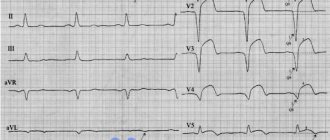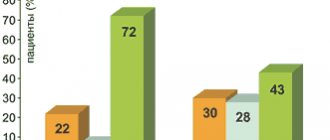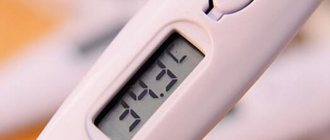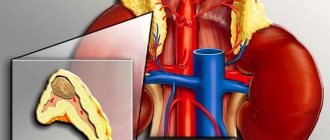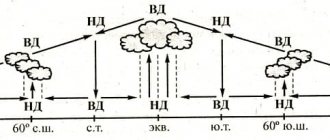Myocardial infarction is a focus of ischemic necrosis (death) of the heart muscle, resulting from an acute circulatory disorder in the coronary artery. Myocardial infarction is one of the most common forms of coronary heart disease (CHD). The condition poses a threat to human health and life and is the leading cause of death among adults in developed countries. Most often, symptoms of myocardial infarction are recorded in men (about 5 times more often than in women), and 70% of all sick people are aged 55–65 years. A heart attack manifests itself with extremely unpleasant symptoms: sharp pain in the chest, shortness of breath, cold sweat, and a feeling of fear. However, with timely identification of risk factors, diagnosis of a heart attack and provision of timely assistance during an attack of myocardial infarction in the clinic, it is possible to avoid tragic consequences.
Causes of heart attack
The direct cause of a heart attack is the sudden occurrence of an obstruction to blood flow in the branches of the coronary artery. In 95–97% of cases, such an obstacle is a blood clot formed as a result of atherosclerotic lesions of the arteries. In other cases, a heart attack occurs without any manifestations of atherosclerosis, and the main cause is a pronounced prolonged spasm of the coronary artery.
In extremely rare cases, myocardial infarction develops as a complication of other diseases (arteritis, developmental anomalies and injuries of the coronary artery, infective endocarditis, etc.). The likelihood of symptoms of an acute heart attack increases several times if the following risk factors are present:
- hyperlipoproteinemia (abnormal increase in the level of lipids and/or lipoproteins in the blood);
- old age (55 years and older);
- male gender;
- physical inactivity (lack of physical activity);
- obesity;
- smoking;
- diabetes;
- hypertonic disease;
- hereditary predisposition (presence of IHD in blood relatives).
Heart Enemy N1
More than half of deaths in Russia are caused by cardiovascular diseases.
This figure is more than three times higher than in developed countries. In addition, the number of patients who returned to a full life after a heart attack, unfortunately, is much less in our country than in these countries. And all because in our country little attention is paid to the prevention of heart diseases and their timely diagnosis. Therefore, when a person finally turns to doctors, they are sometimes already powerless.
And another reason is that people in our country do not know the enemy “by sight.” Meanwhile, even minimal knowledge in this area is an additional chance for a long life.
What is a heart attack
Myocardial infarction is an acute condition caused by the death of an area of heart muscle tissue. What threatens a person in this case:
- cardiac arrest or rupture;
- ventricular fibrillation (that is, their erratic contraction, which always leads to cessation of blood flow even in large arteries);
- acute heart failure or other conditions that really threaten the patient’s life.
Why does this happen
The main cause of the disease is atherosclerosis. If the blood contains certain fats (cholesterol and other lipids) in excess, they are deposited in the wall of large arteries in the form of so-called atherosclerotic plaques. At the most unexpected moment, the plaque, and therefore the inner lining of the artery of the heart, can crack and tear. Blood clots form at this site, closing the lumen of the artery. The blood flow stops, the death of heart cells begins and myocardial infarction develops.
The larger the artery through which blood flow to the heart is stopped, the more myocardial cells will die, and the larger the infarction.
The integrity of the atherosclerotic plaque can be disrupted by rapid heartbeat and increased blood pressure due to stress, severe physical or emotional stress. But often a heart attack develops for no apparent reason, often even in a dream. His “favorite” time is early morning.
Risk factors
- being male (men over 40 and even younger are the most vulnerable group);
- postmenopausal age in women;
- heredity - the presence of relatives in the family who have had early heart attacks;
- elevated blood cholesterol (more than 5 mmol/l or more than 200 mg/dl);
- smoking (one of the most significant risk factors!);
- excess body weight, poor diet and sedentary lifestyle;
- excessive emotional stress;
- increased blood pressure (more than 140/90 mm Hg at any age);
- diabetes.
Even one of these factors creates a real threat of “acquaintance” with myocardial infarction. And if there are more of them, visits to the cardiologist should become regular. And in your home medicine cabinet the presence of nitroglycerin and valocordin is a must.
Harbingers
Everyone is well aware of the term - pre-infarction state. In addition to the appearance of heart pain, a person may experience a feeling of anxiety and depression during this period. But sometimes a heart attack develops immediately from the acute period, without warning signs.
Attention! At the slightest suspicion of a heart attack, immediately call an ambulance - the time factor is crucial here. This is a chance to stay alive. The symptoms of the disease are:
- The main sign of a heart attack is severe pain in the middle of the chest. Feelings of squeezing of the heart, burning.
- The pain can radiate to the jaw, neck, arm, shoulder, back. Similar pain occurs with angina pectoris, but during exercise, and with a heart attack it is more severe and often begins at rest, and does not go away even after taking medications.
- Severe weakness, anxiety, lack of air. Shortness of breath appears, and jumps in blood pressure are noted. The person turns pale and breaks out in a cold sweat.
- Sometimes pain occurs far from the heart. When the pain spreads to the abdominal area or thigh, vomiting or hiccups may occur. In such cases, a heart attack is often confused with food poisoning or diseases of the abdominal organs.
- Sometimes a heart attack is accompanied by an unreasonable increase in temperature to 38.5 degrees. Together with shortness of breath and chest pain, it somewhat resembles an acute cold. Dizziness appears, and the patient may lose consciousness.
If the patient has at least one of these symptoms, without a doubt call an ambulance. Let the doctor do an ECG on site and clarify the diagnosis. After all, with a heart attack, unbearable pain does not necessarily occur.
Prevention
- It was once fashionable to “run from a heart attack,” but now experts consider walking in the fresh air preferable—at least 5-6 kilometers a day.
- Maintain normal blood pressure.
- Normalize your blood sugar levels.
- Stop smoking! This is one of the reliable ways to prevent heart attack.
- Try to lose excess weight. The diet should be low in animal fats and cholesterol. More vegetables and fruits. Instead of pork, replace white poultry meat, replace butter with vegetable oil, preferably olive oil, and lard with fish.
Before the doctor arrives
During the summer season, the number of so-called garden heart attacks increases. Doctors advise: the country first aid kit must contain medications to lower blood pressure, nitroglycerin and a tonometer. It is important to be able to provide first aid to a patient before a specialist arrives.
- If the pain does not go away within 4-5 minutes, place a nitroglycerin tablet under your tongue and wait until it is completely dissolved. Remember that nitroglycerin can dramatically lower blood pressure.
- If the first tablet does not help, you can take another one. But do not take more than five tablets within an hour. You can chew half a tablet of regular aspirin.
And do not hesitate to call an ambulance.
adviсe
Last resort
In case of clinical death (lack of consciousness, breathing and heartbeat, wide pupil), without wasting time and without waiting for a doctor, try to bring the person back to life: ventilate the lungs using mouth-to-mouth artificial respiration, perform chest compressions. Yes, although it is scary to put pressure on a person’s chest during a heart attack, doctors admit that there is simply no other way of resuscitation.
This is how the procedure is described:
- Place the patient on a hard surface.
- Kneel to the side of the victim - at chest level.
- Unfasten his belt and all constricting parts of his clothing.
- Place the heel of your right palm (unless you're left-handed) on the lower third of your sternum. Place the base of the second palm on top, straighten the fingers of both hands so that they form an oblique cross. Leaning on your chest with straight arms, make sharp pressing movements on the chest at a speed of up to 100 times per minute.
- Direct the force strictly vertically. Don't bend your arms.
- The depth of pressure on the sternum is at least 5 centimeters.
Symptoms of a heart attack
In most cases, the first symptoms of myocardial infarction are increasing manifestations of a person’s existing angina:
- pain in the sternum (longer and more intense);
- an increase in the area of pain and the appearance of irradiation (spread of pain to other areas: left arm, shoulder blade, collarbone, jaw);
- a sharp drop in exercise tolerance;
- a significant decrease in the effect of taking nitroglycerin;
- development of shortness of breath at rest, dizziness, general weakness.
Symptoms of a heart attack rarely appear against the background of new-onset angina or after a period of long remission. Often, the occurrence of an acute heart attack is provoked by one of the following factors:
- severe stress;
- significant physical stress;
- severe overheating or hypothermia;
- surgery;
- sexual intercourse;
- binge eating.
The typical course of the disease is characterized by the fact that the main complaints are associated with such symptoms of a heart attack as severe pain, which is localized behind the sternum. The pain can be burning, squeezing, cutting. Often symptoms of myocardial infarction include pain spreading to the left arm, shoulder blade and shoulder. However, antianginal drugs such as nitroglycerin do not have an analgesic effect. Compared to an attack of angina, the duration of pain is increased: from 30 minutes to several days. Even slight physical activity or stress increases pain.
Most people note that the painful symptoms of a heart attack have a pronounced emotional overtones: there is a feeling of fear of death, hopelessness, doom, and intense melancholy. The person becomes easily excitable, may scream, and strive to constantly change body positions. In addition, symptoms of myocardial infarction are severe weakness, shortness of breath, excessive sweating, nausea, vomiting, and dry cough.
The examination reveals in patients such objective symptoms of a heart attack as pale skin with blue discoloration of the nasolabial triangle and nails, the skin is moist to the touch. The pulse rate rises to 90–100 beats per minute, while blood pressure rises slightly. Often in the first days, an increase in body temperature to 37–38 °C is detected.
Symptoms of myocardial infarction (fever)
The patient’s body temperature on the 1st day of MI usually remains normal and increases on the 2nd, less often on the 3rd day. The temperature rises to 37 - 38 °C and stays at this level for 3 - 7 days. In some cases of extensive heart damage, the duration of the temperature reaction can increase to 10 days. A longer subfebrile condition indicates the addition of complications.
High temperature (39 °C or more) is rare and usually occurs when a complication is associated, such as pneumonia. In some cases, the temperature rises slowly, reaching a maximum after a few days, then gradually decreases and returns to normal. Less often, it immediately reaches its maximum value and then gradually decreases to normal.
The magnitude of the temperature increase and the duration of the fever depend to some extent on the extent of the MI, but the body’s reactivity also plays a significant role in this. In young people, the temperature reaction is more pronounced. In elderly and senile people, especially with small focal MI, it may be insignificant or absent. In patients with MI complicated by cardiogenic shock, body temperature remains normal or even decreased.
The appearance of a temperature reaction after an anginal attack is an important diagnostic sign of MI and should always alert the doctor regarding the development of fresh focal changes in the myocardium. MI is characterized by an increase in the number of leukocytes in the blood. It is observed within a few hours after the development of MI and persists for 3–7 days.
Longer leukocytosis indicates the presence of complications. Usually there is a moderate increase in the number of leukocytes in the blood - up to (10 - 12) * 10 9 /l. Very high leukocytosis (over 20*10 9 /l) is considered an unfavorable prognostic sign.
According to some authors, the severity of leukocytosis to a certain extent depends on the extent of myocardial damage. In approximately 10% of cases, leukocytosis may be normal throughout the entire period of the disease. The number of leukocytes in the blood increases mainly due to neutrophils, and a shift in the leukocyte formula to the left is noted. The first days of the disease are characterized by a decrease in the number of eosinophils in the blood, sometimes even to aneosinophilia. Subsequently, their number increases and returns to normal, and in some cases even exceeds normal levels.
“Myocardial infarction”, M.Ya.Ruda
Read further:
Symptoms of myocardial infarction (presystolic rhythm)
Consequences of a heart attack
Myocardial infarction rarely goes away without leaving a trace. Its consequences in the form of complications can significantly reduce life expectancy. The most common complications of a heart attack are:
- early post-infarction angina;
- heart rhythm disturbances;
- cardiogenic shock (sharp decrease in myocardial contractility);
- acute cardiovascular failure;
- cardiac aneurysm (protrusion of the thinned wall of the heart);
- heart rupture (violation of its integrity).
After a heart attack, it is possible to return to a full life; the likelihood of this depends on many factors, including the timeliness and adequacy of treatment of the heart attack, the prevalence of tissue necrosis, and the presence of complications. Unfortunately, the mortality rate from a heart attack is high and amounts to about 35%. A third of those who have had the disease develop circulatory failure, in which people may lose their ability to work and become disabled.
Diagnosis of myocardial infarction
In a typical course, the diagnosis of acute myocardial infarction is performed based on an analysis of the clinical picture of the disease. To confirm the diagnosis, electrocardiography and laboratory diagnostics are used. The presence of an atypical form can usually be determined only with the help of additional methods for diagnosing a heart attack. The main diagnostic signs of myocardial infarction are the following:
- prolonged pain (more than 30 minutes), which is not eliminated with nitroglycerin;
- characteristic pattern on the electrocardiogram;
- an increase in erythrocyte sedimentation rate (ESR), leukocytosis, detected by a general blood test;
- deviation of biochemical parameters from the norm (detection of C-reactive protein, increase in the level of fibrinogen, sialic acids);
- the presence in the blood of markers of myocardial cell death.
It is not difficult to distinguish between the symptoms of myocardial infarction and signs of other diseases with severe pain in the heart area (angina pectoris, pleurisy, pulmonary embolism, spontaneous pneumothorax, intercostal neuralgia, etc.) when diagnosing a heart attack. With an atypical course, it is more difficult: the abdominal form can be mistaken for food poisoning, peptic ulcer, pancreatitis, acute cholecystitis; cerebral form - for a stroke.
Treatment of heart attack
If qualified treatment of myocardial infarction is started in a timely manner, this largely determines the prognosis of the disease and the severity of the consequences. In the most acute and acute periods of the disease, hospital therapy is necessary. Treatment for a heart attack includes:
- relief of pain with analgesics, anesthesia with nitrous oxide for persistent pain;
- oxygen therapy – oxygen inhalations are performed using nasal catheters, flow rate 3–4 l/min;
- restoration of coronary blood flow using thrombolytic therapy;
- improving blood supply to the damaged area of the myocardium with the help of nitrates, β-blockers and calcium antagonists;
- prevention of heart rhythm disturbances using magnesium solution;
- stabilization of the emotional state with the help of sedatives, tranquilizers and psychotherapy;
- compliance with the daily regimen: first bed rest, after 2 weeks - ward rest, minimum physical activity (only dosed walking). The average duration of inpatient treatment for heart attack is 3 weeks.
- Compliance with the diet: diet during the acute period with the exclusion of “heavy” foods from the diet, increasing the frequency of meals and reducing the amount of food consumed at a time.
What mechanism underlies hyperthermia?
In response to the formed necrotic focus, an inflammatory process develops in the body. This is a universal protective reaction designed to eliminate the traumatic factor and restore damaged tissue. The cause of inflammation is metabolic products that have changed their properties as a result of necrosis, hemorrhage or thrombosis.
Any inflammatory process in the body is accompanied by an increase in temperature under the influence of pyrogens (biological compounds that can affect the thermoregulation center).
In the case of an uncomplicated heart attack, the fever is non-infectious. Neutrophilic leukocytes, macrophages and mononuclear cells migrate to the dead area to limit the source of inflammation and absorb tissue breakdown products.
Leukocytes produce pyrogenic substances that cause an increase in temperature: interleukins, interferons, tumor necrosis factor.
When released into the blood, leukopyrogens provoke:
- rapid increase in body temperature;
- increased heart rate;
- increased sweating;
- headache.
Fever may also occur due to complications.
Hypostatic pneumonia appears 5-7 days after the onset of the disease Her reasons:
- decreased blood supply to the lungs;
- deterioration of their ventilation;
- forced physical inactivity;
- the presence of opportunistic microflora, nosocomial infections;
- violation of the rules of patient care in intensive care;
- decrease in the body's overall resistance.
In addition to the increase in temperature, the patient has a cough, shortness of breath, general weakness, clinically - a decrease in the amount of oxygen in the blood, neutrophilic leukocytosis, and areas of darkening on the radiograph. In the case of pneumonia, the fever is infectious and requires antibiotic treatment.
In the long-term period, fever is caused by the development of parietal thromboendocarditis and post-infarction syndrome (Dressler).
Parietal thromboendocarditis develops at 3-4 weeks in patients who have had extensive transmural or subendocardial myocardial infarction. Small detached blood clots, entering the systemic bloodstream, cause blockage of blood vessels in the brain, kidneys, and intestines, which can be accompanied by fever.
Dressler's syndrome develops at 3-6 weeks of illness. The process is based on a delayed-type hypersensitivity reaction. Circulating immune complexes formed with autoantibodies settle on the serous membranes, causing their inflammation.
Clinical signs:
- Fever up to 39-400C.
- Polyserositis (pneumonitis, pleurisy, pericarditis, synovitis of large joints).
- Pain on palpation of the sternocostal and sternoclavicular joints.
- Acceleration of ESR, eosinophilia, leukocytosis.
- Rarely - hemorrhagic vasculitis, kidney damage.
In rare cases, a rise in body temperature may occur at the same time as the onset of a heart attack. This is explained by the release of a large amount of adrenaline into the blood and psychogenic stimulation of the thermoregulation center. Also, temporary fever accompanies myocardial reperfusion after balloon angioplasty and coronary stenting.
Prevention of heart attack
The goal of primary prevention of myocardial infarction is to combat coronary heart disease and eliminate risk factors. Quitting smoking, maintaining an active lifestyle, systematic moderate physical activity, maintaining normal body weight, and a balanced diet will help prevent the development of a heart attack.
Secondary prevention aims to combat the development of recurrent infarctions: preventive measures include the prescription of anticoagulants, β-blockers, and calcium antagonists. An important point is to ensure patency of the coronary artery. This can be accomplished by cardiac bypass surgery or stenting of cardiac vessels.
If you need an examination to identify risk factors or treat a heart attack, the ABC-Medicine clinic offers you its assistance. To ask any question you are interested in about diagnosing a heart attack or any other aspects of the problem, as well as to make an appointment with a specialist, call +7.

